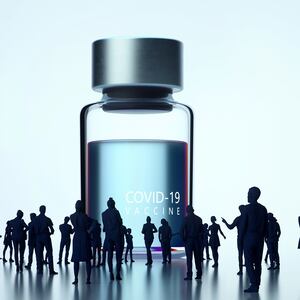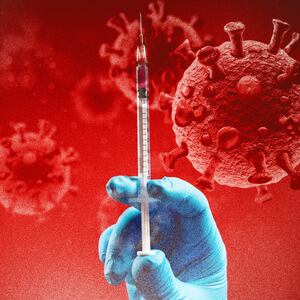COVID infections are up in many U.S. states as new variants spread, state and local authorities end social distancing rules and mask mandates, and pandemic-weary Americans let down their guard.
If that weren’t bad enough, fewer and fewer of those same tired Americans are getting tested for the virus. Fewer tests means less data—and less early warning when new variants evolve and spread.
Welcome to Rabbit Hole, where we dive deep on the biggest story. It’s for Beast Inside members only. Join up today.
ADVERTISEMENT
Health experts are unanimous in calling for more testing. “We need to track these variants, at a minimum,” Pierre Mourad, a University of Washington bio-engineer, told The Daily Beast.
But they’re also unanimous in acknowledging there are no easy ways to boost testing rates. “You have to make it easy, fast, cheap, and protected,” Christopher Mason, a biophysicist at Weill Cornell Medicine in New York, told The Daily Beast.
Nationwide stats tell a clear story. Daily testing rates were really low early in the pandemic, peaked as the virus was at its most prevalent, and then ebbed as vaccinations surged and cases dropped.
On average, fewer than 200,000 Americans got tested every day in the six months after the novel coronavirus first appeared in China.
To a great extent, limited testing infrastructure was to blame. There were too few testing sites, some test-providers charged high fees, and the turnaround time at many locations was so long—weeks, sometimes—that testing wasn’t even very useful to individuals. By the time you knew you were infected, you might already have come into close contact with a lot of other people.
Testing was such a hassle that, generally speaking, only people who suspected they might be COVID-positive even bothered. That’s one reason why, early in the pandemic, around one in five tests came back positive.
More testing sites were established, stronger government support for testing kicked in and new, faster, and more convenient test types became available—including the first saliva tests, which don’t require an uncomfortable nasal swab.
Through mid-summer and early fall, around a million Americans a day got tested, including a lot of people who had no real reason to suspect they were infected. The positive rate dropped to less than 10 percent, on average.
The winter surge in COVID cases drove a huge expansion of testing. Two million people got swabbed—or spit into a vial—every day through February. The positive rate climbed higher than 10 percent.
The spike in testing meant a deluge of data for health officials and scientists. Geneticists had more raw material to work with. That helped them to identify and track dangerous new variants—“lineage” is the technical term—that originated in the United Kingdom, South Africa and Brazil and quickly spread to the United States.
America’s world-class vaccination campaign really revved up in the past couple of months. The rate of new infections dropped fast in January and February. At the mid-March low point, just 4 percent of tests came back positive.
But as cases declined, so did testing. Millions more Americans were getting vaccinated every day. Despite a lineage-fueled spring surge in Michigan, New York, Florida, and other states—and despite population-level “herd immunity” being many months away—governors and mayors rushed to end mask mandates and restrictions on businesses and gatherings.
Millions of Americans seemed ready to declare victory over SARS-CoV-2 and move on with their lives. That fatigue weighed on testing. The daily rate of new tests dropped to around 1.3 million.
While that’s a lot better than the rate from a year ago, it’s not nearly enough to satisfy epidemiologists who are trying to keep tabs on the U.K., South African, and Brazilian lineages while also looking out for whatever lineages might come next. “If we are not testing sufficiently, it will be harder to detect new variants,” Stephanie James, the head of a COVID testing lab at Regis University in Colorado, told The Daily Beast.
The novel coronavirus isn’t going anywhere. Even after the United States achieves herd immunity by vaccinating around three-quarters of the population, the virus will survive in small pockets of infected people—and possibly in animal populations, as well. “Inevitably more variants can and will emerge,” Mason said.
COVID could come back, much like the flu does, every year. Future SARS-CoV-2 lineages might require different public health strategies and new boosters for the vaccines. But tailoring a response means understanding these possible future lineages—and the sooner after they evolve, the better.
That requires what experts call “genetic surveillance.” Geneticists working out of computer-packed labs run samples through powerful sequencing software.
They need a steady flow of fresh samples from hospitals, pharmacies and local governments. Testing is the only way to gather those samples from the general population. “So really, are we testing enough and are we sequencing enough samples?” James asked.
Somehow, health officials need to incentivize people to keep getting tested, even after the pandemic is over.
Or, at least, feels like it’s over.
No one knows how to do that. “Jeez, I don’t know,” Mourad said after mulling the testing-incentive problem. “We have trouble getting some people to even get vaccinated!”
Local governments could mandate a certain amount of testing. But even a modest mandate could be extraordinarily controversial, especially among conservatives and anti-vaxxers. “I don’t know how people would react to that,” James said, “but my guess is not well.”







